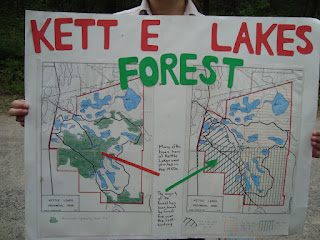
Saturday, August 29, 2009
Nighthawk Common this summer

Wednesday, August 19, 2009
My Puddingstone visit, pictures and maps
 The glacier brought the stone within one hundred kilometers of Timmins, Larry brought it the rest of the way.
The glacier brought the stone within one hundred kilometers of Timmins, Larry brought it the rest of the way.Tuesday, August 18, 2009
Timmins Likes Pudding Stone
A 10-ton mosaic rock, discovered in the bush about 60 kilometres west of Timmins, has found a new home in Flintstone Park on Rea St. N.
Larry Robichaud, who made the geological find while camping west of the Groundhog River in Reeves Township a year ago, said this product of volcanic process is quite unique for Northern Ontario and has drawn the interest of the Geology Department at the University of Toronto.
"My first impression was that it looked like a block of cement with lots of rocks in it," said Robichaud, who noticed it just off a bush road in Reeves Township when he was camping by himself for a week last August. "I started looking at it more closely and it struck my interest. I did some research and found out that it was a puddingstone. It would have come here from down south."
He said the rock could have only arrived here after being carried and dumped by a receding glacier during North America's last ice age.
A puddingstone, also known as zenolith, is a sedimentary rock that consists of a mixture of different, irregular sized grains and pebbles held together in a matrix of finer materials such as sand.
It was only after speaking with geologists at the University of Toronto that Robichaud felt some effort should be made to bring it to Timmins where others could see it for themselves
"They told me, 'If you ever get to move it, we'd like to come see it.' That kind of convinced me that more people needed to see this."
Robichaud was able to achieve this last week with assistance and support with the Mattagami Region Conservation Authority and the crane operating firm of RLP/CMS.
Last Wednesday, Leo Madore, crane operator for RLP/CMS and Robichaud spent six hours unearthing, hoisting, loading up, and relocating the huge rock using a 26-ton boom truck to Flintstone Park.
In keeping with its new location, Robichaud said the rock has been named Fred's Puddingston
Daily Press Story
Wikipedia
Pudding stone blog
Sunday, August 16, 2009
Garden Growth and Spotted Tussock Moth
 While walking back into the house a little Spotted Tussock Moth (Lophocampa maculata) was walking across the grass. I brought it into the house and put it on my young lads bare back. He is very use to his Dad doing things like this. He did not jump, he barely looked up from his computer. "Ya dad what is it"?
While walking back into the house a little Spotted Tussock Moth (Lophocampa maculata) was walking across the grass. I brought it into the house and put it on my young lads bare back. He is very use to his Dad doing things like this. He did not jump, he barely looked up from his computer. "Ya dad what is it"?Wednesday, August 5, 2009
Wild Orange Daylily - Learn something new every day



Tuesday, August 4, 2009
Learning about Trees



Scotch Pine Provenance Test



Kettle Lakes - Trees for Canada
Year Township Number and Species
1980 German (KLP) 11 000 White spruce and Jack pine
1981 Massey 10 000 Jack pine
1982 Carscallen 10 000 Jack pine
1983 Denton 8 525 White spruce
1984 Carscallen 5 000 Jack pine
1985 Murphy 5 000 Jack pine
1986 Murphy 5 000 Jack pine
1987 Deloro 5 000 Jack pine
1988 Deloro 5 000 Jack pine
1989 Evelyn 5 000 Jack pine
1990 Little 6 150 Jack pine
1991 Macklem 5 000 Jack pine
1992 Macklem 5 150 Jack pine
1993 Macklem 4 400 Jack pine
1994 Evelyn 2 500 Jack pine
1995 Evelyn 4 500 Jack pine
1996 German 3 500 Jack pine
**********100 725 seedling to date!***********
1997 German? 3000 jackpine
1998 German? 3000 jackpine
1999 German? 3000 jackpine
2000 German? 2500 jackpine
2001 Tisdale 2000 Jack pine
2002 Tisdale 2000 Jack pine
2003 Tisdale 1 600 White spruce and 100 White pine








